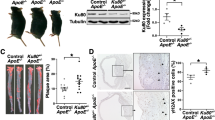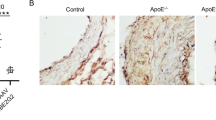Abstract
Atherosclerosis (AS), characterized by a maladaptive inflammatory response, is one of the most common causes of death among the elderly. Karyopherin subunit alpha 2 (KPNA2), a member of the nuclear transport protein family, has been reported to play a pro-inflammatory role in various pathological processes by regulating the nuclear translocation of pro-inflammatory transcription factors. However, the function of KPNA2 in AS remains unknown. ApoE−/− mice were fed high-fat diets for 12 weeks to establish an AS mice model. Human umbilical vein endothelial cells (HUVECs) were treated with lipopolysaccharide (LPS) to establish an AS cell model. We found that KPNA2 was upregulated in the aortic roots of atherosclerotic mice and LPS-stimulated cells. KPNA2 knockdown inhibited LPS-induced secretion of pro-inflammatory factors and monocyte-endothelial adhesion in HUVECs, whereas KPNA2 overexpression exerted the opposite effects. p65 and interferon regulatory factor 3 (IRF3), the transcription factors known to regulate the transcription of pro-inflammatory genes, interacted with KPNA2, and their nuclear translocations were blocked following KPNA2 silencing. Furthermore, we found that KPNA2 protein level was decreased by E3 ubiquitin ligase F-box and WD repeat domain containing 7 (FBXW7), which was downregulated in the atherosclerotic mice. FBXW7 overexpression induced ubiquitination with subsequent proteasomal degradation of KPNA2. Meanwhile, the effects of KPNA2 deficiency on atherosclerotic lesions were further confirmed by in vivo experiments. Taken together, our study indicates that KPNA2 downregulation, regulated by FBXW7, may alleviate endothelial dysfunction and related inflammation in the progression of AS by suppressing the nuclear translocation of p65 and IRF3.









Similar content being viewed by others
Data Availability
The data that support the findings of this study are available from the corresponding author upon reasonable request.
References
Frostegård, J. 2013. Immunity, atherosclerosis and cardiovascular disease. BMC Medicine 11: 117.
Zhu Y., X. Xian, Z. Wang, et al. 2018. Research progress on the relationship between atherosclerosis and inflammation. Biomolecules 8.
Ross, R. 1999. Atherosclerosis–an inflammatory disease. The New England Journal of Medicine 340: 115–126.
Libby, P. 2021. The changing landscape of atherosclerosis. Nature 592: 524–533.
Macara I.G. 2001. Transport into and out of the nucleus. Microbiology and Molecular Biology Reviews : MMBR 65.
Chook, Y.M., and G. Blobel. 2001. Karyopherins and nuclear import. Current Opinion In Structural Biology 11: 703–715.
Sun, C., Z. Yu, Y. Wang, and T. Tao. 2016. The importin protein karyopherin-β1 regulates the mice fibroblast-like synoviocytes inflammation via facilitating nucleus transportation of STAT3 transcription factor. Biochemical and Biophysical Research Communications 471: 553–559.
Liu, Z., D. Zhang, C. Sun, et al. 2015. KPNA2 contributes to the inflammatory processes in synovial tissue of patients with rheumatoid arthritis and SW982 cells. Inflammation 38: 2224–2234.
Cai Z., M.-X. Zhang, Z. Tang, et al. 2020. USP22 promotes IRF3 nuclear translocation and antiviral responses by deubiquitinating the importin protein KPNA2. The Journal of Experimental Medicine 217.
Mallavia, B., C. Recio, A. Oguiza, et al. 2013. Peptide inhibitor of NF-κB translocation ameliorates experimental atherosclerosis. The American Journal of Pathology 182: 1910–1921.
Leonard, A., A. Rahman, and F. Fazal. 2018. Importins α and β signaling mediates endothelial cell inflammation and barrier disruption. Cellular Signalling 44: 103–117.
Ysebrant de Lendonck, L., V. Martinet, and S. Goriely. 2014. Interferon regulatory factor 3 in adaptive immune responses. Cellular and Molecular Life Sciences : CMLS 71: 3873–3883.
Liu H., W.-L. Cheng, X. Jiang, et al. 2017. Ablation of interferon regulatory factor 3 protects against atherosclerosis in apolipoprotein E-deficient mice. Hypertension (Dallas, Tex : 1979) 69: 510–20.
Davignon J., and P. Ganz. 2004. Role of endothelial dysfunction in atherosclerosis. Circulation 109: III27–III32.
Mao, Y., W. Luo, L. Zhang, et al. 2017. STING-IRF3 triggers endothelial inflammation in response to free fatty acid-induced mitochondrial damage in diet-induced obesity. Arteriosclerosis, Thrombosis, and Vascular Biology 37: 920–929.
Kumar, K.P., K.M. McBride, B.K. Weaver, C. Dingwall, and N.C. Reich. 2000. Regulated nuclear-cytoplasmic localization of interferon regulatory factor 3, a subunit of double-stranded RNA-activated factor 1. Molecular and Cellular Biology 20: 4159–4168.
Qin, L., H. Zhang, B. Li, et al. 2021. CCM3 loss-induced lymphatic defect is mediated by the augmented VEGFR3-ERK1/2 signaling. Arteriosclerosis, Thrombosis, and Vascular Biology 41: 2943–2960.
Yumimoto, K., S. Akiyoshi, H. Ueo, et al. 2015. F-box protein FBXW7 inhibits cancer metastasis in a non-cell-autonomous manner. The Journal of Clinical Investigation 125: 621–635.
Lan, H., and Y. Sun. 2019. FBXW7 E3 ubiquitin ligase: Degrading, not degrading, or being degraded. Protein & Cell 10: 861–863.
Zheng, B., C.-Y. Zheng, Y. Zhang, et al. 2018. Regulatory crosstalk between KLF5, miR-29a and Fbw7/CDC4 cooperatively promotes atherosclerotic development. Biochimica Et Biophysica Acta Molecular Basis of Disease 1864: 374–386.
Shen, Y., X. Chen, C. Chi, et al. 2019. Smooth muscle cell-specific knockout of FBW7 exacerbates intracranial atherosclerotic stenosis. Neurobiology of Disease 132: 104584.
Hänle-Kreidler, S., K.T. Richter, and I. Hoffmann. 2022. The SCF-FBXW7 E3 ubiquitin ligase triggers degradation of histone 3 lysine 4 methyltransferase complex component WDR5 to prevent mitotic slippage. The Journal of Biological Chemistry 298: 102703.
An, H.-J., C.-J. Lee, G.-E. Lee, et al. 2022. FBXW7-mediated ERK3 degradation regulates the proliferation of lung cancer cells. Experimental & Molecular Medicine 54: 35–46.
Suehiro, K.-I., A. Suto, K. Suga, et al. 2021. Sox12 enhances Fbw7-mediated ubiquitination and degradation of GATA3 in Th2 cells. Cellular & Molecular Immunology 18: 1729–1738.
Zhang, Y., Y. Gu, Y. Chen, et al. 2021. Dingxin Recipe IV attenuates atherosclerosis by regulating lipid metabolism through LXR-α/SREBP1 pathway and modulating the gut microbiota in ApoE mice fed with HFD. Journal of Ethnopharmacology 266: 113436.
Rosenfeld, M.E. 2015. Converting smooth muscle cells to macrophage-like cells with KLF4 in atherosclerotic plaques. Nature Medicine 21: 549–551.
Tabas, I., G. García-Cardeña, and G.K. Owens. 2015. Recent insights into the cellular biology of atherosclerosis. The Journal of Cell Biology 209: 13–22.
Glass, C.K., and J.L. Witztum. 2001. Atherosclerosis. the road ahead. Cell 104: 503–516.
Chistiakov, D.A., A.A. Melnichenko, A.V. Grechko, V.A. Myasoedova, and A.N. Orekhov. 2018. Potential of anti-inflammatory agents for treatment of atherosclerosis. Experimental and Molecular Pathology 104: 114–124.
Zhao, Y., D.A. Howatt, F. Gizard, et al. 2010. Deficiency of the NR4A orphan nuclear receptor NOR1 decreases monocyte adhesion and atherosclerosis. Circulation Research 107: 501–511.
Karin, M., and Y. Ben-Neriah. 2000. Phosphorylation meets ubiquitination: The control of NF-[kappa]B activity. Annual Review of Immunology 18: 621–663.
Popli, S., S. Chakravarty, S. Fan, et al. 2022. IRF3 inhibits nuclear translocation of NF-κB to prevent viral inflammation. Proceedings of the National Academy of Sciences of the United States of America 119: e2121385119.
Liu, N., J.-T. Liu, Y.-Y. Ji, and P.-P. Lu. 2010. C-reactive protein triggers inflammatory responses partly via TLR4/IRF3/NF-κB signaling pathway in rat vascular smooth muscle cells. Life Sciences 87: 367–374.
Cai, Y., Y. Shen, L. Gao, et al. 2016. Karyopherin alpha 2 promotes the inflammatory response in rat pancreatic acinar cells via facilitating NF-κB activation. Digestive Diseases and Sciences 61: 747–757.
Brand, K., S. Page, G. Rogler, et al. 1996. Activated transcription factor nuclear factor-kappa B is present in the atherosclerotic lesion. The Journal of Clinical Investigation 97: 1715–1722.
Hofmann, M.A., E. Lalla, Y. Lu, et al. 2001. Hyperhomocysteinemia enhances vascular inflammation and accelerates atherosclerosis in a murine model. The Journal of Clinical Investigation 107: 675–683.
Hershko, A. 1983. Ubiquitin: Roles in protein modification and breakdown. Cell 34: 11–12.
Pickart, C.M., and M.J. Eddins. 2004. Ubiquitin: Structures, functions, mechanisms. Biochimica Et Biophysica Acta 1695: 55–72.
Huang, G., Z. Xiang, H. Wu, et al. 2022. The lncRNA BDNF-AS/WDR5/FBXW7 axis mediates ferroptosis in gastric cancer peritoneal metastasis by regulating VDAC3 ubiquitination. International Journal of Biological Sciences 18: 1415–1433.
Chong, Z., C. Bao, J. He, et al. 2018. E3 ligase FBXW7 aggravates TMPD-induced systemic lupus erythematosus by promoting cell apoptosis. Cellular & Molecular Immunology 15: 1057–1070.
Liao J., X. Su, M. Wang, et al. 2022. The E3 ubiquitin ligase CHIP protects against sepsis-induced myocardial dysfunction by inhibiting NF-κB-mediated inflammation via promoting ubiquitination and degradation of karyopherin-α 2. Translational Research : the Journal of Laboratory and Clinical Medicine.
Kattah, M.G., B.A. Malynn, and A. Ma. 2017. Ubiquitin-modifying enzymes and regulation of the inflammasome. Journal of Molecular Biology 429: 3471–3485.
Bories, G.F.P., and N. Leitinger. 2017. Macrophage metabolism in atherosclerosis. FEBS Letters 591: 3042–3060.
Barrett, T.J. 2020. Macrophages in atherosclerosis regression. Arteriosclerosis, Thrombosis, and Vascular Biology 40: 20–33.
He, J., Y. Song, G. Li, et al. 2019. Fbxw7 increases CCL2/7 in CX3CR1hi macrophages to promote intestinal inflammation. The Journal of Clinical Investigation 129: 3877–3893.
Funding
This study was funded by the 345 Talent Project in Shengjing Hospital of China Medical University.
Author information
Authors and Affiliations
Contributions
Z. X. and Y. Z. conceptualization; Z. X., Y. Z., and J. C. methodology; Z. X., Y. Z., and M. D. investigation; Z. X., Y. Z., D. L., and R. L. data curation; Z. X. and Y. Z. writing-original draft; J. Z. writing—reviewing and editing; J. Z. supervision.
Corresponding author
Ethics declarations
Ethics Approval and Consent to Participate
This study was performed according to guidelines provided by the Animal Care Use Committee of Shengjing Hospital of China Medical University (No: 2022PS813K) and was approved by the committee.
Competing of Interest
The authors declare no competing interests.
Additional information
Publisher's Note
Springer Nature remains neutral with regard to jurisdictional claims in published maps and institutional affiliations.
Supplementary Information
Below is the link to the electronic supplementary material.
Rights and permissions
Springer Nature or its licensor (e.g. a society or other partner) holds exclusive rights to this article under a publishing agreement with the author(s) or other rightsholder(s); author self-archiving of the accepted manuscript version of this article is solely governed by the terms of such publishing agreement and applicable law.
About this article
Cite this article
Xing, Z., Zhen, Y., Chen, J. et al. KPNA2 Silencing, Regulated by E3 Ubiquitin Ligase FBXW7, Alleviates Endothelial Dysfunction and Inflammation Through Inhibiting the Nuclear Translocation of p65 and IRF3: A Possible Therapeutic Approach for Atherosclerosis. Inflammation 46, 2071–2088 (2023). https://doi.org/10.1007/s10753-023-01863-w
Received:
Revised:
Accepted:
Published:
Issue Date:
DOI: https://doi.org/10.1007/s10753-023-01863-w




